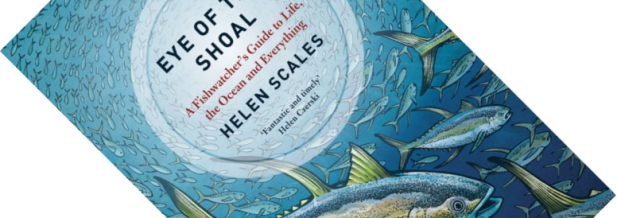Helen Scales is a marine biologist, diver, and surfer, and is no stranger to writing good books. I have previously read Poseidon’s Steed: The Story of Seahorses, from Myth to Reality from her hand. The book after that, Spirals in Time: The Secret Life and Curious Afterlife of Seashells, received critical praise in the press and was shortlisted for the Royal Society of Biology book prize. Here, Scales turns her attention to fish. Is this another page-turner waiting to be recognised?

“Eye of the Shoal: A Fish-Watcher’s Guide to Life, the Ocean and Everything”, written by Helen Scales, published by Bloomsbury Sigma (a Bloomsbury Publishing imprint) in May 2018 (hardback, 320 pages)
Fish have a bit of a PR problem, being considered cold and slippery, living in a world we can only access with great effort, and more often praised for their taste than for anything else. Having studied the sex life of a fish species for five years I’m a bit of an outlier myself, but most people are thoroughly unaware just how rich and multi-faceted the lives of fish are. Blue Planet II did a good job recently of (again) showing us this, but even if you have seen that, Scales has plenty of surprises in store.
Eye of the Shoal starts off giving a short history of ichthyology, the science of fish studies, and then walks us through the evolutionary tree to introduce the twelve main groups. Say “fish”, and most people will picture a teleost, the evolutionary youngest and most diverse group, making up some 96% of the roughly 30,000 currently known fish species. But there are eleven others. Scales then spends seven chapters on a particular aspect of their biology or ecology, richly mixing it with personal anecdotes of diving trips and research she has done.
“Fish have a bit of a PR problem […]”
Scales covers the dazzling colours of fish and their function, the bioluminescence so often seen in deep-sea species (see also my review of Deep-Sea Fishes: Biology, Diversity, Ecology and Fisheries), shoaling and schooling behaviour, eating and hunting, toxic fish, prehistoric fish, and fish vocalisations. Each chapter shows some of the marvellous aspects of their biology, from dragonfish communicating on private channels in the deep sea using red light, damselfishes tending to seaweed gardens, toxic fish all independently evolving the same mutations to be immune to their own poison, to the many ways in which fish can vocalise. There are famous textbook examples that will be familiar to fish biologists, such as the Trinidadian guppies that Losos discussed in Improbable Destinies: How Predictable is Evolution? and the Lake Victoria cichlids, popularised in Darwin’s Dreampond: Drama in Lake Victoria, but also bizarre cases such as the now-extinct shark genus Helicoprion that had a spiral-toothed jaw looking like a circular saw blade, which recently got a book-length treatment in Resurrecting the Shark: A Scientific Obsession and the Mavericks Who Solved the Mystery of a 270 Million Year Old Fossil. Fittingly, Scales ends the book with a chapter what all these findings mean for how we treat and think about fish, touching on that contentious debate on whether or not they feel pain. For the record, she and many other scientists think they do, and I would say the reasons why make perfect sense.
“[…] this book does its best on all levels to convince you that fish are worthy of our attention.”
Scales is enamoured by fish, and she effortlessly transports readers to their underwater world. Though thoroughly grounded in recent scientific work, she doles out the science lightly – whether it’s the intricacies of electroreception in fish, the physics of their vision, or the finer details of their hearing. Mixed in is a healthy dose of work by scientific pioneers and their discoveries. I knew Konrad Lorenz for his work on goslings, but I never knew he had an enormous aquarium built at his house and spent the last few years of his life observing fish behaviour. I was similarly not familiar with the long and distinguished career of Eugenie Clarke who studied sharks and pufferfish, amongst many others. Finally, each chapter ends with a short traditional tale or myth from various cultures around the globe in which fish feature prominently.
If all of this wasn’t enough to hold your attention, the book is lovingly produced. From the illustrated endpapers to the beautiful drawings that preface each chapter (with an appendix identifying the fish shown), this book does its best on all levels to convince you that fish are worthy of our attention. Many people will never venture underwater, but this absorbing book is the next best thing.
Disclosure: The publisher provided a review copy of this book. The opinion expressed here is my own, however.

, hardback or ebook
Other recommended books mentioned in this review:
__________________________________________________________________
__________________________________________________________________








One comment